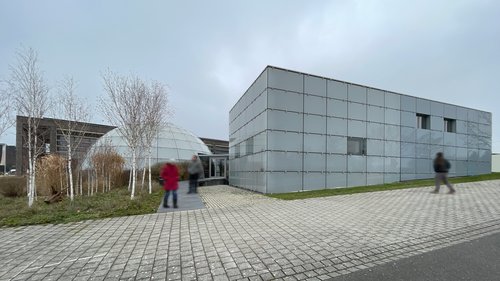Retrospective BIM approach for life cycle-optimised integration of BIPV systems
bifa – Sub-project: Recycling and retrospective life cycle analysis

bifa – Sub-project: Recycling and retrospective life cycle analysis
The aim of the joint project was to increase the acceptance and use of building-integrated photovoltaic systems (BIPV) by integrating the Building Information Modelling (BIM) method and using visually appealing PV surfaces to enhance the aesthetics of façades. For demonstration purposes and as a real-world laboratory, the façade surface of the Danish pavilion at the Hanover Exhibition Centre was made available for use. Here, data could be collected over the entire life cycle of a BIPV system. This data was fed into a digital twin and formed the basis for validating the practical suitability and digital application possibilities.
The bifa sub-project focused on the development of tools and methods that allow the systematic consideration of buildings with façade-integrated BIPV systems from the design phase through the entire life cycle.
Focus of the project
- Examination of the life cycle (planning– production– construction– operation –recycling) of a specific demonstration object with a view to increasing material and energy efficiency, with a particular focus on the operational phase and energy optimisation through low-investment measures
- Further development in the field of energy building simulation, building monitoring, building management technology and energy-efficient operational optimisation in conjunction with digital methods
- Development of innovative planning, construction and operational processes for controlling information flows on the digital BI(M)PV platform
Project results
All project results were compiled in a practical guide for stakeholders in the life cycle of BIPV systems and expanded to include a digital BIMPV platform that maps the processes and information in the life cycle based on the digital twin.
Participating institutions:
- Lehrstuhl und Institut für Baumanagement, Digitales Bauen und Robotik im Bauwesen (ICoM), RWTH Aachen University, Aachen;
- Institut für Solarenergieforschung GmbH (ISFH), Emmerthal;
- CAE - Center for Applied Energy Research e.V., Würzburg;
- bifa Umweltinstitut GmbH, Augsburg;
- albert.ing GmbH, Frankfurt am Main;
- LHR - Lang Hugger Rampp Architekten GmbH, München;
- nD-System GmbH, Hannover;
- nD-enerserve GmbH, Hemmingen
Der Schlussbericht kann bei der Technischen Bibliothek Hannover abgerufen werden.
